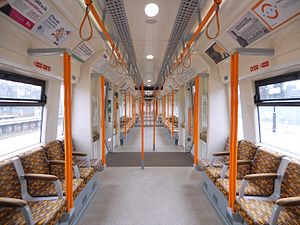| British Rail Class 378 Capitalstar | |
|---|---|
 London Overground Class 378 at Wandsworth Road | |
 The interior of a Class 378 unit | |
| In service | 29 July 2009 – present |
| Manufacturer | Bombardier Transportation |
| Built at | Derby Litchurch Lane Works |
| Family name | Electrostar |
| Replaced | |
| Constructed |
|
| Number built | 57 |
| Successor | Class 710[a] |
| Formation |
|
| Fleet numbers |
|
| Capacity |
|
| Owners | Transport for London[1] |
| Operators | London Overground |
| Lines served | |
| Specifications | |
| Car body construction | Welded aluminium body with steel cab ends |
| Train length | 101.350 m (332 ft 6.2 in) |
| Car length |
|
| Width | 2.800 m (9 ft 2.2 in) |
| Height | 3.774 m (12 ft 4.6 in) |
| Floor height | 1.151 m (3 ft 9.3 in)[2] |
| Doors | Double-leaf pocket sliding, each 1.5 m (4 ft 11 in) wide (2 per side per car) |
| Wheel diameter | 840 mm (2 ft 9 in) (nominal)[2] |
| Wheelbase |
|
| Maximum speed | 75 mph (121 km/h) |
| Weight |
|
| Steep gradient | 1 in 29[2] |
| Traction motors | 3 per motor car, each of 600 kW (800 hp) |
| Power output | 2,400 kW (3,200 hp)[2] |
| Electric system(s) |
|
| Current collector(s) |
|
| Bogies |
|
| Braking system(s) |
|
| Safety system(s) | |
| Coupling system | Dellner 12 |
| Multiple working | Within class, and with Classes 375, 376, 377 and 379 |
| Seating | Longitudinal |
| Track gauge | 1,435 mm (4 ft 8+1⁄2 in) standard gauge |
| Notes/references | |
| Sourced from [3] and [4] unless otherwise noted. | |
The British Rail Class 378 Capitalstar[5] is an electric multiple unit passenger train specifically designed for the London Overground network. It is part of Bombardier Transportation's Electrostar family. A total of 57 five-car trains have been built, most of which were originally built as three- or four-car units.
The Class 378s were ordered in August 2006 in response to passenger dissatisfaction with existing mass-transit trains operated by Silverlink, such as the ageing fleet of Class 313. The procurement of a modern replacement was viewed as yielding better performance than the refurbishment of the existing units. Accordingly, a total of 57 Class 378s were manufactured at Bombardier's Derby site; the first example of which entered revenue service during July 2009. The type's introduction was roughly half a year later than originally planned, largely as a result of difficulties with multiple suppliers.
In design terms, the train is broadly similar to the Class 376 trains operated by Southeastern, featuring the same wider metro-style sliding pocket doors for more efficient boarding and alighting. However, it also has significant differences from the Class 376, such as fully longitudinal seating similar to that used on London Underground rolling stock to give more standing and less seating capacity and reduce overcrowding; the interior was optimised for the high-volume metro-style services being operated by London Overground.
Cite error: There are <ref group=lower-alpha> tags or {{efn}} templates on this page, but the references will not show without a {{reflist|group=lower-alpha}} template or {{notelist}} template (see the help page).
- ^ Lynch, Ben (12 July 2023). "London Overground: Rising interest rates behind unbudgeted £281m spend on trains, TfL confirms". London World. Retrieved 22 September 2024.
- ^ a b c d e Jacob, Gemma (17 August 2016). "London Overground Class 378 Details". Letter to Adam Palfrey. Transport for London. Retrieved 1 October 2022.
- ^ Hall, Peter (February 2012). British Railways Locomotives & Coaching Stock 2012. Sheffield: Platform 5 Publishing. p. 292. ISBN 978-1-90233-692-3.
- ^ Class 378 Information Sheet (PDF) (1 ed.). Transport for London. 2 November 2018. Retrieved 13 December 2020.
- ^ Pritchard, R. (November 2008). "TfL's first Class 378 ready to roll!". Today's Railways UK. Sheffield. p. 32.